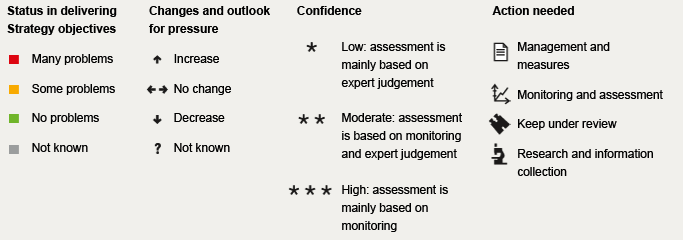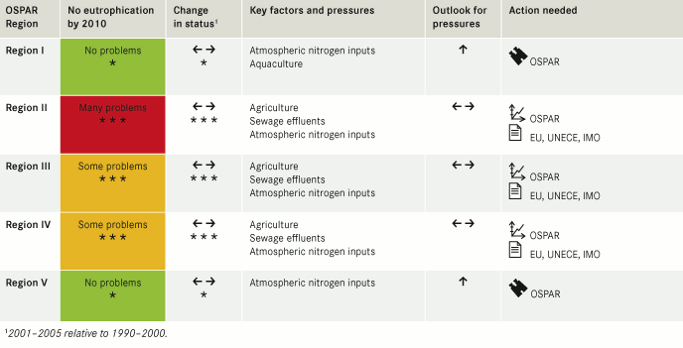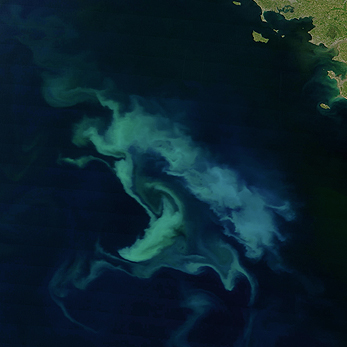
What happens next?
The OSPAR objective of no eutrophication will not be met by 2010
A healthy marine environment where no human-induced eutrophication occurs was not achieved in the period 2001–2005. While eutrophication is not a problem in Regions I and V, many areas of Region II, including areas in the Channel, Skagerrak and Kattegat, and some small coastal embayments and estuaries within Regions III and IV are still affected by eutrophication. Eutrophication is a more prominent problem in coastal areas than offshore waters.
Progress in improving the status has been slow:
- In many cases, measures targeting nutrient sources have been taken later than envisaged.
- It can take many years for ecosystems to respond to nutrient reductions at source, because nutrients in sediments and soil may contribute to local nutrient budgets over long periods.
- Transboundary transport of nutrients into and within Region II has been shown to contribute to eutrophication problems.
Further actions are needed to improve problem areas
OSPAR countries with problem areas have made substantial progress towards the OSPAR target of 50% reductions in nutrient discharges and losses compared to 1985. Reductions of up to 85% have been achieved for phosphorus while progress for nitrogen has been less successful with only few reductions of up to 50%. Modelling studies suggest that significant further reductions of nutrient inputs, beyond 50% to some problem areas, will be required to eliminate eutrophication problems.
The main contributions of nutrients to problem areas are discharges and losses from agriculture, urban waste water and industry, and from atmospheric deposition.
To achieve a status where eutrophication does not occur, OSPAR countries should take the following actions:
- Fully implement the relevant OSPAR and EU measures as soon as possible Table 4.1 and promote consideration of marine eutrophication when implementing the EU Nitrates Directive.
- Take, if necessary, additional measures (e.g. via river basin management plans set up under the EU Water Framework Directive) to address sources contributing to problem areas.
- Cooperate to set appropriate reduction targets for nutrient inputs for individual problem areas.
- Improve monitoring and coordinate data collection on sources, inputs and environmental status in order to direct measures.
Atmospheric nutrient loads need to be addressed
There is concern about the level of atmospheric nitrogen deposition to the OSPAR area from agriculture, combustion processes and road transport, and about the increasing absolute and relative contribution from shipping to airborne inputs. Marine eutrophication has yet to be taken into account in international measures setting air emission targets and standards. OSPAR should take the following actions:
- Promote the recognition of marine eutrophication in the revision of air emission targets for nitrogen under the EU National Emission Ceilings Directive and the Gothenburg Protocol to the UNECE Convention on Long-range Transboundary Air Pollution.
- Evaluate the contribution of atmospheric nitrogen emissions, including those from ships, in eutrophication assessments and use these results to promote that marine eutrophication is taken into account in the revision of standards for ship emissions of oxidised nitrogen set by the International Maritime Organization (IMO).
Assessment framework to support the EU Marine Strategy Framework Directive
The Common Procedure provides a good tool for a robust assessment of the eutrophication status of the North-East Atlantic. It also provides a good example of how countries can provide a common approach to determining good environmental status under the EU Marine Strategy Framework Directive and good ecological status under the EU Water Framework Directive.
New observational tools such as instrumented buoys Figure 4.8, ferry boxes, airborne surveillance and remote sensing, have the potential to complement traditional sampling and to help in the design of cost-efficient monitoring programmes to enhance the evidence base for future eutrophication assessments through better spatial and temporal coverage. However, they do not yet offer the same guarantee of quality-assured biogeochemical observations as is achieved by monitoring water quality using scientific research vessels.
Future monitoring and assessment should be supported by the following actions:
- Refinement of the methodologies of the Common Procedure, including assessments of individual indicators at regional level.
- Coordinated use of new observational tools to complement the OSPAR eutrophication monitoring programme.
- Continued cooperation on evaluating transboundary nutrient transport and improved knowledge through modelling.
There is increasing evidence that climate change may alter eutrophication effects. OSPAR should continue to improve knowledge on the interactions of climate change and eutrophication and should take these interactions into account in future eutrophication-related monitoring and assessment.
Delivering OSPAR Strategy objectives for eutrophication



